In October 2025, the Zambia Information and Communications Technology Authority (ZICTA) initiated a public consultation on proposed licensing guidelines for the 71–76 GHz and 81–86 GHz E-Band spectrum. This initiative is aligned with the ICT Act No. 15 of 2009 and reflects ZICTA’s regulatory mandate to allocate and manage spectrum efficiently.

The E-Band provides 10 GHz of contiguous spectrum that enables multi-gigabit wireless backhaul and fixed wireless access (FWA) solutions. ZICTA sees this band as crucial for national network upgrades, especially in delivering cost-effective alternatives to fiber for 5G and other high-bandwidth services.
Two-Tier Licensing Framework
The proposed guidelines divide the E-Band into two sub-bands to serve different deployment needs:
Coordinated Block (71.125–73.125 GHz paired with 81.125–83.125 GHz): Requires a valid Network Licence and is intended for high-availability deployments. Channels are arranged in 250 MHz increments (up to 1,000 MHz), following ITU-R F.2006 recommendations.
Self-Coordinated Block (73.375–75.875 GHz paired with 83.375–85.875 GHz): Open to any applicant with verifiable identification. Supports more flexible and potentially lower-cost deployments. Channels may be aggregated up to 2,000 MHz and used in either FDD or TDD mode.
A 250 MHz guard band (73.125–73.375 GHz) separates the two blocks to prevent interference.
Application Process and Spectrum Fees
Applicants for the Coordinated Block must already hold a network license covering their intended service area. In contrast, access to the Self-Coordinated Block is open to any applicant, reflecting a more innovation-friendly model than seen in other African markets.
Licensing fees are structured as follows:
Coordinated Block: ZMW 1,666.80 annually per 250 MHz paired link
Self-Coordinated Block: ZMW 416.80 annually per link
A uniform ZMW 66.80 application fee applies to both blocks
Applications must follow the 2024 Radiocommunication Regulations, and deployment may only begin upon formal license issuance.
Interference Resolution Procedures
Self-coordinated users are expected to manage interference collaboratively using a first-in-time principle:
Affected licensees must notify the source of interference in writing.
The source has 24 hours to respond and work toward resolution.
If unresolved, the case may be escalated to ZICTA.
The Self-Coordinated Links Register, a public database, determines link priority based on registration date.
In contrast, interference in the Coordinated Block must be reported directly to ZICTA for investigation and resolution.
Technical Standards and Equipment Compliance
Mandatory technical conditions for E-Band use include:
Frequency range: 71.125–75.875 GHz / 81.125–85.875 GHz
Max EIRP: 55 dBW
Min antenna gain: +38 dBi
Max transmit power: +30 dBm
Out-of-band emissions: Limited to -55 dBW/MHz outside band edges
All equipment must be type approved by ZICTA prior to importation or installation. Users are also required to comply with other national authorities, including Zambia’s Civil Aviation Authority and Environmental Management Agency, for infrastructure and safety compliance.
For this article’s source information and any product certification guidance, please contact Global Validity.
Quick Country Facts
Zambia
Certification Body: Zambia Information and Communications Technology Authority (ZICTA)
Certification Type: Mandatory
License Validity: Indefinite
Application Language: English
Legal License Holder: Manufacturer
In-Country Testing Requirement: Testing Not Required
The regulatory information above is based on radio type approval certification. Access additional certification requirements in over 200 countries and territories with Global Validity’s free proprietary product certification management software, Access Manager. Learn more about the platform here or fill our quick contact form!
Global Validity is your partner for global certification success
Want to learn more about regulatory compliance and how we can help? Simply fill out the form below and we’ll be in touch!
